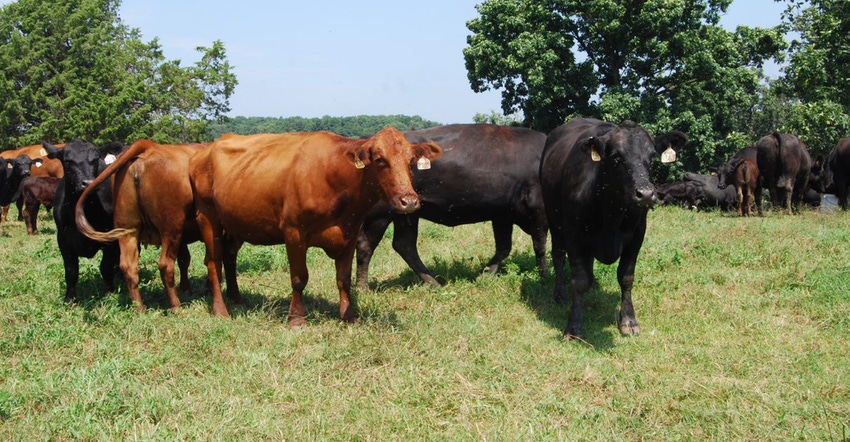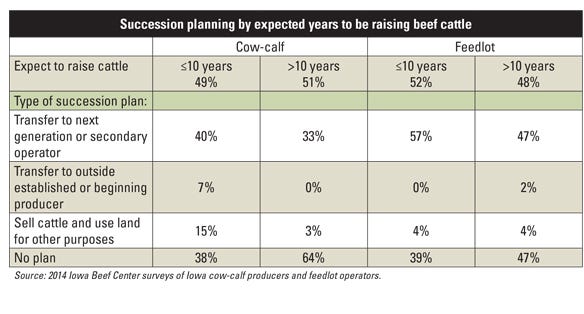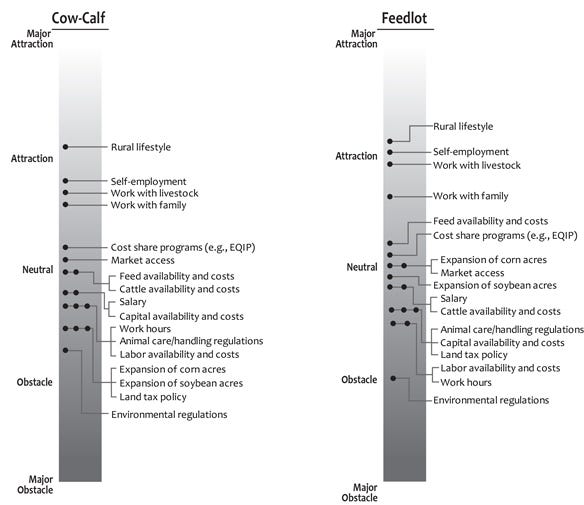June 18, 2019

People ― the producers who make it happen — are the most important asset in Iowa’s cattle industry. But they’re aging. Almost twice as many cow-calf and feedlot producers are over 64 as are under 35.
Specifically, the average age of Iowa cow-calf and feedlot producers is 53.2 and 52.9 years, respectively. Today, 25% of Iowa cow-calf and 22% of Iowa cattle feedlot producers are over age 64. An additional 25% of cow-calf and 28% of feedlot producers are between 55 and 64.
Current demographics, including producer age and equity distribution, are skewed to older producers. That means a large share of Iowa’s beef production assets will change hands over the next decade or two.
Public policy will influence how, and to whom, these assets will be transferred, which in turn will help shape beef cattle production for generations to come. This makes it crucial for policymakers, stakeholder groups and educators to explore and evaluate alternative policies to enable successful farm successions. Specifically, policies targeting environmental regulations, competition for land, capital availability, capital costs and land tax policy could help facilitate — or hinder — intergenerational transfers of assets in Iowa’s beef cattle industry.
Few producers with plans in place
About half of the Iowa cow-calf producers and feedlot operators responding to a 2014 Iowa Beef Center survey expect to be raising cattle for 10 more years or less. A significant number of producers with relatively short time horizons do not have a succession plan. Thirty-eight percent of the cow-calf producers and 39% of the feedlot operators who expect to be raising cattle for 10 more years or less do not have a succession plan in place. This is particularly alarming, as a realistic time frame for farm succession is often 10 to 15 years.

The survey also asked producers to indicate the degree to which different factors were perceived as an obstacle or attraction for future generations entering cattle production. Cow-calf producers said they view rural lifestyle, self-employment, and the ability to work with livestock and family as the biggest attractions.
The top perceived obstacles for future generations among cow-calf producers were environmental regulations, land tax policy, and expansion of corn and soybean acres. Feedlot operators identified the same attractions as the cow-calf producers; however, the highest-ranking obstacles were mostly different, except environmental regulations, and included work hours, as well as labor availability and costs.
Crop production synergies
Iowa ranks No. 1 in production of corn and ethanol, which supplies distillers grain coproduct for livestock feed. This beef cattle and corn production combination provides a unique synergistic system that can give Iowans competitive economic advantages.
However, this combination can also lead to challenges. Two are competition for land and available labor supply. For example, the average size of an Iowa cow-calf operation is 164 acres. The average size of an Iowa feedlot is 528 acres. These are smaller than the U.S. averages of 565 acres for cow-calf operations and 1,058 acres for cattle feedlots.
Over the last 20 years, 1999 to 2018, Iowa pastureland asset value surged 356%, and pastureland cash rent rose 74%, according to USDA National Ag Statistics Service’s land value and cash rent surveys of producers.
In 2017, 72% of Iowa cow-calf producers worked at least one day off the farm, while 54% worked 200 or more days off the farm. This was slightly lower for Iowa feedlot producers, with 49% working at least one day off the farm, while 29% worked greater than or equal to 200 days off the farm. Thirty-five percent of Iowa cow-calf producers reported farming as their primary occupation, while 67% of Iowa feedlot producers listed farming as their primary occupation.
The need to supplement farm income from off-farm sources may put future beef cattle producers at a large disadvantage when it comes to recruiting new producers.
Why? Cattle production systems are typically far from metropolitan areas, and thus have fewer off-farm income opportunities nearby.
Iowa’s economic engine
Iowa has 17,863 cow-calf producers and 4,106 feedlot producers, according to the 2017 Census of Agriculture, using the breakdown by the North American Industry Classification System. Those people are owners and operators of 10,415 cow-calf operations and 2,325 cattle feedlots. Decisions these producers, and their potential successors, make will determine the future size and structure of the Iowa beef cattle industry.
Iowa is the fourth-largest cattle-feeding state in the U.S., marketing just over 1.81 million head in 2018. Iowa is also the 10th-largest cow-calf state, with 950,000 beef cows as of Jan. 1.
Perceived obstacles and attractions for future generations entering beef cattle production

Source: 2014 Iowa Beef Center surveys of Iowa cow-calf producers and feedlot operators
Iowa’s $4.06 billion of cash receipts for cattle and calves in 2017 represent 15% of all Iowa agricultural cash receipts and 30% of all Iowa animal and animal product cash receipts. These cattle production figures alone represent significant economic activity, but they’re a mere fraction of the total economic activity stimulated by the beef cattle industry. In addition to the direct economic effects and input purchases resulting from beef production, processing and input supply activities, income earned in these agriculturally related components of the beef industry helps fuel the rest of the economy.
To learn more, read Succession Planning and Perceived Obstacles and Attractions for Future Generations Entering Beef Cattle Production in Iowa.
Changes in Ag Census definitions
Demographic data from the 2017 Census of Agriculture aren’t fully comparable to 2012 and earlier census data due to terminology and definition changes.
The 2012 Ag Census included data for the principal operator, which was one person per farm. Allowing only one principal operator didn’t reflect farms where multiple family members contribute equally to decisions for the farm operation.
For the 2017 Ag Census, the questionnaire was changed to allow farmers and ranchers to designate multiple people per farm as principal producers. Subsequently, this changed how some data items are reported.
The 2012 Ag Census provided cattle and calf sales by age and primary occupation of the principal operator. In 2012, older producers accounted for almost half of total Iowa cattle and calf sales: 15% of sales were accounted for by principal operators (farming and other occupations) age 65 and over, and an additional 31% of sales were accounted for by principal operators age 55 to 64. These data are not provided for 2017.
New and beginning producers is a new category for 2017. It includes producers operating on any operation for 10 years or less. They may be on farms with producers who are not beginning producers. Also, a young producer is defined as a producer 35 years of age or younger. Farms with a young producer, or a new and beginning producer account for roughly 20% of the market value of livestock, poultry and their products sold in Iowa.
Three-fourths of those young or new producers are also principal operators. When any young or new producer is a principal operator, only about 12% of the market value of livestock, poultry and their products sold in Iowa come from those farms.
Both these 2012 and 2017 Ag Census statistics suggest older producers who hold most of the equity will need to be involved in facilitating the transition to the younger generation.
Schulz is the ISU Extension livestock economist. Email [email protected].
You May Also Like




